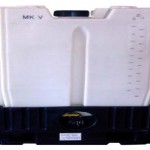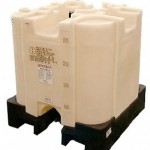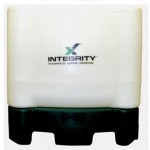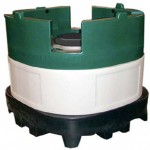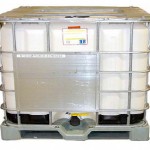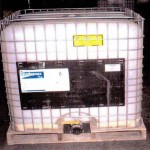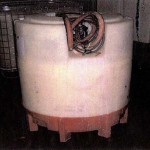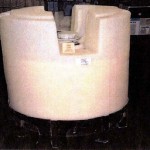Attributed to Size, Use, Material and Manufacture
Also included are Container Management Terms, listed below Definitions / Descriptions
Container Definitions
Asset Tank – Also known as Rotationally Molded Tanks, these tanks are designed and constructed for multiple trips and many years of use. Asset Tanks are manufactured in capacities of 60 to 330 gallons, and typically are constructed of Rotationally Molded Polyethylene (most common) or Stainless Steel (not as common). New units or tanks already in service must meet all requirements of the August 2011 EPA Container and Containment Rule.
(Images #1, #2, #3, #4)
Caged Tank – Also known as Bottle in Cage Tanks, Caged IBC and Composite IBC, see Composite IBCs for description.
(Images #5, #6)
Composite IBC – Also known as CagedIBC, Caged Totes and Caged Tanks, these Intermediate Bulk Containers (IBCs) are designed for multiple trips and many years of use in a program that includes inspection, reconditioning, or replacement of the inner plastic container and valve. These units are constructed with three primary components – a blow molded inner plastic container made typically from natural HDPE plastic with UV-blocking additive; a surrounding galvanized steel cage; and a base made from steel, both steel and plastic, or wood. Composite IBCs are sold in 275 gallon or 330 gallon sizes, depending on make and model; 275 gallon is the more popular size. New units or tanks already in service must meet all requirements of the August 2011 EPA Container and Containment Rule.
(Images #5, #6)
Deposit IBC – This is a general term for IBCs that involve the end-user leaving a deposit at time of purchase. Once the IBC is returned to the manufacturer, or contractor acting on behalf of the manufacturer, the deposit is reimbursed to the end-user. This term can apply to any type of container including Caged Tanks and Asset Tanks. New units or tanks already in service must meet all requirements of the August 2011 EPA Container and Containment Rule.
(Images #1, #2, #3, #4, #5, #6)
Drum – This container type is blow molded of high density high molecular weight polyethylene (HDPE) in capacities from 15 to 55 gallons (most common). Drums can be constructed of Stainless Steel (not as common). Refillable drums can be part of Mini Bulk and IBC (Intermediate Bulk Container) management programs. New refillable drums, or refillable drums already in service must meet all requirements of the August 2011 EPA Container and Containment Rule. Single trip drums are accepted in the ACRC (Ag Container Recycling Council) program for HDPE container recycling.
IBC Tote – Also known as Bottle in Cage Tanks, Caged Tanks and Composite IBCs, see Composite IBCs for description.
(Images #5, #6)
Intermediate Bulk Container (IBC)
– This is a Department of Transportation term for containers that have capacities larger than 119 gallons and are designed for mechanical handling. IBCs are typically, but not always, reusable.
(Images #1, #2, #3, #4, #5, #6)
Jug or Bottle – This container type is blow molded of high density (fractional melt) polyethylene (HDPE) ranging in size from half pints to 3 gallons. Typically Jugs or Bottles are not part of Mini Bulk and IBC (Intermediate Bulk Container) management programs. However, Jugs and Bottles are part of the ACRC (Ag Container Recycling Council) program for HDPE container recycling.
Limited Use Tanks – This category describes tanks that need to be removed from service (either immediately or within 2.5 years) because they do not meet the requirements in the August 2011 EPA Container and Containment Rule. It includes Composite IBCs that are not in a program that includes inspection, reconditioning or replacement of the inner plastic container and valve. It also includes older containers that do not have the DOT markings and are not authorized for use by the registrant of the pesticide, such as the containers in Images #7, #8.
Long Term Use Tank – This term generally applies to Asset Tanks, Asset IBCs and Rotationally Molded Tanks.
(Images #1, #2, #3, #4)
Mini Bulk – A group term for containers, typically reusable in capacities from 60 through 330 gallons and includes all Totes, Tanks and IBCs described here.
Non-bulk Container – This represents a Department of Transportation term for containers that have capacities of 119 gallons or less. Non-bulk containers include jugs, bottles, drums and small portable refillable containers.
Nonrefillable Container – A term from the August 2011 EPA Container and Containment Rule for pesticide containers that describes containers not intended to be filled with a pesticide more than once. These are also referred to as one-way or disposable containers. Jugs, bottles, and bags are generally nonrefillable containers. Drums, minibulks, and IBCs can be nonrefillable or refillable containers, depending on the intent of the pesticide manufacturer.
Portable Refillable Container (PRC) – A group term from the August 2011 EPA Container and Containment Rule for Mini Bulk and IBC containers that can be easily moved, refilled and reused, caged or not. PRCs include all Totes, Tanks and IBCs described here.
Refillable Container – A term from the August 2011 EPA Container and Containment Rule for pesticide containers that describes containers intended to be filled with a pesticide more than once. These are often referred to as reusable containers. Drums, Mini Bulks, and IBCs can be nonrefillable or refillable containers, depending on the intent of the pesticide manufacturer.
Rotationally Molded Polyethylene Tank – Also known as Rotomold, Asset Tank and Asset IBC, these tanks are typically free standing, made from high density polyethylene in a rotationally molded process vs. blow molded, and are not part of Caged Tank designs. New Rotationally Molded tanks already in service must meet all requirements of the August 2011 EPA Container and Containment Rule.
(Images #1, #2, #3, #4)
Shuttle – A group term for Intermediate Bulk Containers (IBC) and Mini Bulk.
Stainless Steel Tank – An asset tank constructed in stainless steel.
Totes – A group term for Intermediate Bulk Container (IBCs) and Mini Bulks and are typically Caged Units.
(Images #5, #6)
Container Management Terms
Return – As part of a preset return program, a pesticide end-user returns empty IBCs (intermediate bulk containers), Mini Bulk tanks or drums to a central location. In many situations, containers can be picked up at the end-user location and delivered to the retail or recycling location. Return programs are generally for refillable containers, although some registrants operate return programs for nonrefillable drums.
Rinse, Re-rinse and Re-rinse – This process in pesticide container management is also known as triple-rinsing. Pressure rinsing is also an approved method for cleaning pesticide containers. Rinsing used pesticide jugs, drums, Mini Bulk tanks and IBC totes through a triple rinse or pressure rinse process is required by the pesticide label, and allows containers to be refilled with pesticide or classified as clean, solid waste (non-hazardous waste) for recycling, reconditioning or disposal
Refill – This process refers to refillable pesticide containers that are returned to the pesticide manufacturer or retailer, typically under a return program, to be refilled with a pesticide. The containers may need to go through periodic retesting, replacing parts or being rinsed before being refilled to sell or distribute pesticides to end use applicators. Containers that will be refilled with a pesticide must comply with the refillable container and repackaging requirements in the August 2011 EPA Pesticide Container and Containment (PCC) rule.
- Rededicate: This is a subset of refilling, and refers to a situation where a container is refilled with a different pesticide product than it held before. The opposite situation is when a container is dedicated to a specific pesticide product and is refilled only with that pesticide product. A decision to rededicate a container can be made by the refiller but must comply with the repackaging contract, description of acceptable containers and refilling residue removal procedure from the pesticide registrant.
Periodic Re-test – The August 2011 EPA Pesticide Container and Containment (PCC) rule requires many refillable pesticide containers to pass periodic retests and inspections required by the Department of Transportation (DOT). See the flow charts on EPA’s regulations for full details, but containers larger than 119 gallons that are marked with the UN symbol must pass a DOT leakproofness test and external DOT inspection every 2.5 years and must pass an internal DOT inspection every 5 years. Containers that pass the leakproofness test and inspection must be marked with the date of the re-test and inspection.
Recondition – This process includes cleaning, testing, repairing and/or otherwise modifying containers (mini bulk tanks, IBC totes or drums) so they can be used again. In 49 CFR 178.350, DOT defines the following three activities for reprocessing emptied IBCs, which are all considered forms of reconditioning by industry: remanufacturing, repairing, and routine maintenance. These activities can be done by an IBC manufacturer or a reconditioner. IBC manufacturers can be reconditioners, but most reconditioners are not manufacturers. The “Composite IBC Compliance Manual (April 2011)” developed by the Reusable Industrial Packaging Association (RIPA) and the DOT regulations define these terms as:
- Remanufactured IBC: A metal, rigid plastic or composite IBC produced as a UN* type from a non-UN type, or converted from one UN design type to another UN design type. An inner receptacle produced by one manufacturer that is placed into a frame produced by another manufacturer (or vice versa) is remanufacturing and requires full UN/DOT qualification testing for hazardous materials.
- Repaired IBC: A metal, rigid plastic or composite IBC that is restored so as to conform to the design type and is able to withstand the design type tests (i.e., qualification testing). The inner receptacle of a repaired IBC may be replaced with another inner receptacle of the same design from the original manufacturer. The bodies and inner receptacles of composite IBCs are not repairable.
- Routine maintenance (IBC): A routinely maintained IBC is a metal, rigid plastic or composite IBC that is cleaned, with body closures reinstalled or replaced in conformance with the original manufacturer’s specifications. Or, restoration of structural equipment not performing a hazardous materials function (e.g. legs) as necessary to conform to the design type.
*UN = United Nations Certification for Packaging Codes
Recycle – This process refers to a series of activities by which discarded materials – pesticide containers in this case – are collected, sorted, processed, and converted into raw materials and used in the production of new products, such as field drain pipe. Pesticide containers must be triple rinsed or equivalent according to the pesticide label instructions before being recycled. The American National Standards Institute (ANSI) and the American Society of Agricultural and Biological Engineers (ASABE) have published a voluntary national consensus standard for recycling plastic containers from pesticides and pesticide related products (ANSI/ASABE S596 FEB2006).
